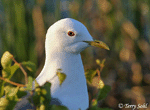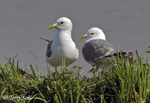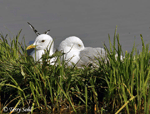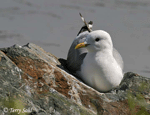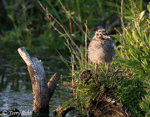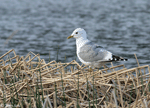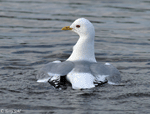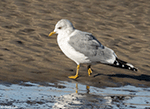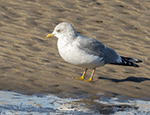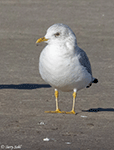| Length: 16 to 18 inches | Wingspan: 42 inches | Seasonality: Rare Visitor |
| ID Keys: (mature birds) Yellow unmarked bill, greenish-yellow legs, white spots in wing tips, small rounded head | ||
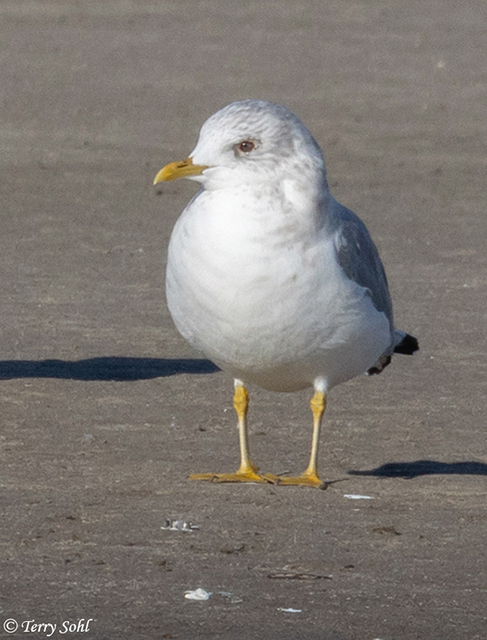 A rare visitor to the
state, the Mew Gull can be differentiated from similar gulls by the lack of any
spots on its bill, it's yellow legs, it's rounded "petite" looking head, and its
relatively small size. The name comes from the cat-like call it often
gives. Mew Gulls are found across the northern Hemisphere, including
races in Europe and Asia. There it is often referred to as the "Common
Gull"
A rare visitor to the
state, the Mew Gull can be differentiated from similar gulls by the lack of any
spots on its bill, it's yellow legs, it's rounded "petite" looking head, and its
relatively small size. The name comes from the cat-like call it often
gives. Mew Gulls are found across the northern Hemisphere, including
races in Europe and Asia. There it is often referred to as the "Common
Gull"
Photo - The photo to the right is from near Pierre, South Dakota on January 2nd, 2021. Additional photos can be found below, or on the dedicated photo page here..
Habitat:
Most often found around wooded lakes and rivers when on its summer breeding grounds. In winter, found along the Pacific coastline, especially near river mouths and brackish lagoons.
Diet:
Omnivorous. Primary diet is often dependent upon season and location. Common food items, include fish, crustaceans, mollusks, insects, earthworms, small rodents, young birds and eggs, berries, grain, carrion, and refuse.
Behavior:
Will use a wide variety of foraging techniques, including walking along the ground or in shallow water, swimming, or dipping down to the water's surface while in flight.
Breeding:
Non-breeder in South Dakota. Mew Gulls are typically colonial nesters on their breeding grounds. The nest is a shallow broad cup built of grasses, and sometimes lichens, mosses, or other vegetative material. It is place on the ground, in a small tree, on a rocky ledge, or whatever traditional nesting location is found at a given location. They are the only "typical" (Larus) gull that will nest in trees. The female lays 2 to 4 eggs, with both parents helping to incubate the eggs. The young hatch after about 25 days.
Song:
Repeated Kee-ya or cat-like Mee-you.
1Click here to hear the typical calls of a Mew Gull, recorded near Nome, Alaska.
2Click here to hear alarm calls of a Mew Gull, recorded in Sweden.
Migration:
Summers throughout Northwestern Canada and Alaska. Winters along the Pacific Coast. Rarely migrates inland south of its breeding range, and is thus a rare visitor to South Dakota.
Interactive eBird Map:
Click here for an interactive eBird map of Mew Gull sightings
Similar Species:
Somewhat similar to many other Larus gulls. Click here to look at identification keys for "typical gulls", including the Mew Gull.Key features that are characteristic of the Mew Gull (adult plumage) are as follows:
- Bill: Small, relatively thin, uniformly yellow bill without any spots at the bill tip (unlike some other Larus gulls)
- Legs: Yellow legs
- Head: Small, rounded head
- Eyes: Dark-looking eyes, with red orbital ring in breeding plumage
- Size: Small size compared to most other Larus species, particularly those commonly seen in South Dakota. Noticeably smaller than Herring Gull or California Gull, and slightly smaller than our ubiquitous Ring-billed Gull.
Conservation Status:
Numbers appear to be stable throughout their normal range. They are found over a very broad geographic area, and are common to abundant in parts of that range. The IUCN considers the Mew Gull to be a species of "Least Concern".
Further Information:
1) Patuxent Bird Identification InfoCenter, Mew Gull
Audio File Credits:
1Peter Boesman, XC322828. Accessible at www.xeno-canto.org/322828.
2Patrik Aberg, XC448150. Accessible at www.xeno-canto.org/448150.
| Click on the map below for a higher-resolution view |
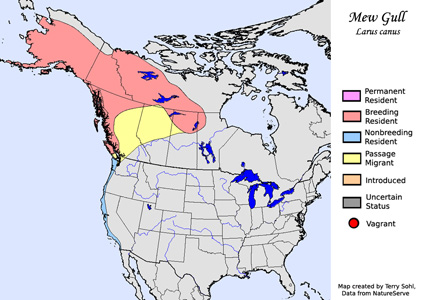 |
| South Dakota Status: Accidental visitor to South Dakota, with most sightings around Missouri River reservoirs. |
Additional Mew Gull Photos
Click for a higher-resolution version of these photos
